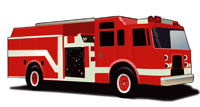The GPS system was developed to meet military needs, but new ways to use its capabilities in everyday life are continually being found. As you have read, the system has been used in aircraft and ships, but there are many other ways to benefit from GPS. We’ll mention just a few to give you an idea of its many uses.
 |
GPS is helping to save lives and property across the nation. In 2002, it enabled rescuers to drill a shaft to free trapped miners in Somerset PA. Many police, fire, and emergency medical-service units use GPS receivers to determine the police car, fire truck, or ambulance nearest to an emergency, enabling the quickest possible response in life-or-death situations. GPS-equipped aircraft can quickly plot the perimeter of a forest fire so fire supervisors can produce updated maps in the field and send firefighters safely to key hot spots.
Mapping, construction, and surveying companies use GPS extensively. During construction of the tunnel under the English Channel, British and French crews started digging from opposite ends: one from Dover, England, and one from Calais, France. They relied on GPS receivers outside the tunnel to check their positions along the way and to make sure they met exactly in the middle. Otherwise, the tunnel might have been crooked. GPS allows mine operators to navigate mining equipment safely, even when visibility is obscured.
 |
Remember the example of the car with a video display in the dashboard? Vehicle tracking is one of the fastest-growing GPS applications today. GPS-equipped fleet vehicles, public transportation systems, delivery trucks, and courier services use receivers to monitor their locations at all times for both efficiency and driver safety.
Automobile manufacturers are offering moving-map displays guided by GPS receivers as an option on new vehicles. The displays can be removed and taken into a home to plan a trip. Several major rental car companies have GPS-equipped vehicles that give directions to drivers on display screens and through synthesized voice instructions. Imagine never again getting lost on vacation, no matter where you are.
GPS-equipped balloons monitor holes in the ozone layer over the polar regions as well as air quality across the nation. Buoys tracking major oil spills transmit data using GPS to guide cleanup operations. Archaeologists, biologists, and explorers are using the system to locate ancient ruins, migrating animal herds, and endangered species such as manatees, snow leopards, and giant pandas.
The future of GPS is as unlimited as your imagination. New applications will continue to be created as technology evolves. GPS satellites, like stars in the sky, will be guiding us well into the 21st century.